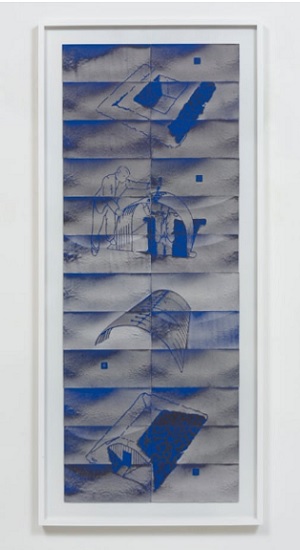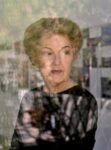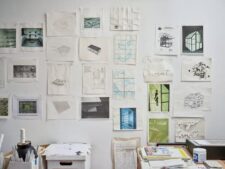
Mary Kelly
American, 1941- (active England)
How to Build an Outdoor Bomb Shelter, 2016
compressed lint
60 x 23 x 2.8 in.
SBMA, Museum purchase with funds provided by the Luria/Budgor Family Foundation
2023.2.1

Mary Kelly in her Los Angeles studio. Credit Philip Cheung
Talking about the rollback of Roe v. Wade, she said, “The immediate effect on the lives of women isn’t just physical — it’s enormously psychological.” - Mary Kelly

Works in progress in Kelly’s home studio. Credit Philip Cheung
COMMENTS
This past August, two months after the Supreme Court overturned Roe v. Wade, Kelly and I sat in her Los Angeles backyard at a table overlooking the pool where she swims laps. Now 81, she was soft-spoken and poised, her hair swept into an elegant updo. As she laid out plates of snacks and poured small glasses of chardonnay — it is a “feminist imperative,” she said, to embrace pleasure — she told me that the impacts of the women’s movement, the enduring theme of her work for more than half a century, had been on her mind. “Since so many of the demands have not been met, what is the legacy?” she asked calmly. “What’s left?” The rollback of abortion protections is something she never could have imagined after the gains of the 1970s, and the attack on reproductive freedoms horrifies her. But Kelly herself is not despairing — she noted that she never could have predicted the #MeToo movement, either. She considers history in context, describing incremental change on a geological scale. “The older I get, and the more we recognize the huge crises like climate change,” she said, “the more I see this as just a very brief period of time.”
Kelly first came to prominence in the 1970s with a practice that was both highly conceptual and unapologetically political. Though she was known as a socialist who tried to unionize artists alongside factory workers, and as a boundary pusher who brought feminism to the testosterone-driven realm of conceptual art, arguably the most radical aspect of her work, especially in its early years, was its insistence that maternity and domesticity were worthy subjects of serious creative expression. At a time when many conceptual artists were focused on violence and transgression — Chris Burden dragging his half-naked body across a parking lot strewn with glass; Paul McCarthy smearing himself with paint, ketchup, mayonnaise, raw meat and feces — Kelly’s early work was almost understated and excruciatingly intimate, with an emphasis on motherhood, pregnancy and reproductive sexuality. While some feminist writers addressed these topics, too, most feminist visual artists at the time were focused on other subject matter: The so-called Pictures Generation in New York was repurposing and appropriating mass media, exploring how culture represented bodies and gender; Martha Rosler was collaging images from Playboy into news photographs to protest the war in Vietnam; Judith Bernstein was making waves by drawing phalluses over and over; and Jenny Holzer was papering her “Truisms” around Manhattan. Kelly’s introspective, conceptual approach made her an anomaly.
Born in 1941 in Fort Dodge, Iowa, and mostly raised in a small town in Minnesota, Kelly came from a background that she describes as “loosely Catholic” and modest — six people living in an 800-square-foot house. From an early age, she painted and drew; as a fourth grader, she was commissioned to create a Nativity scene by a local church. She was fascinated by the beatniks and their travels, and craved culture and education. Later, she got a scholarship through the Catholic Church to study painting in Florence, Italy, where one of her tutors recommended her for a job teaching studio art in Beirut, Lebanon. “I was only 22, but I jumped on it,” she said. It was there that she discovered a new kind of political consciousness, one that became enmeshed with her feelings about gender. “In Beirut there was this long view of colonial history,” Kelly said. She stayed in the country through the Six Day War, even as most Americans fled, and then moved to London in 1968, drawn by the city’s budding conceptual art scene.
Studying at St. Martin’s School of Art, she became involved in the leftist student movements of the era. She met her partner, the artist Ray Barrie, who was a fellow student, when she saw one of his sculptures and felt she had to know who made it; they have been together ever since. For the first seven years of their relationship, Kelly and Barrie lived in a sort of urban commune in Pimlico that was run by women and “whoever we happened to want to be living with at the time,” Kelly said. “It was the very beginning of the women’s movement. It was like the wives and girlfriends of the New Left Review decamped to their own separate organization. Women [were] recognizing that we wanted more of a role than photocopying fliers — or no, then it was operating a mimeograph machine.”
Collective living was a social experiment — shared child care, shared meal prep (Kelly remembers eating a lot of mackerel) — and one connected to the storm of political organizing brewing in London at the time. In 1973, Kelly became the first chairwoman of the Artists’ Union, a group seeking to align itself with the trade union movement. While the Trades Union Congress ultimately turned the artists down for affiliation, and the Artists’ Union more or less fell apart, organizing became part of Kelly’s artistic practice, the most direct example of which is “Nightcleaners,” a seminal avant-garde documentary that she filmed with members of Berwick Street Film Collective between 1970 and 1975. The film includes interviews with women who cleaned London offices after hours and depicts their daily routines — dropping off children at school, washing up, shopping, preparing dinner, then going out to mop floors and empty trash cans. It highlighted their low pay, as well as the psychological and physical consequences of such labor. “The reason you come to work at night is because you’ve got children, schoolchildren,” one of the subjects tells Kelly in the film. “You’re not just doing it for the fun of it … it’s for getting a little extra to put on the table, to clothe our children.”
It was while shooting “Nightcleaners” and documenting the campaign for equal pay at a local factory that Kelly noticed that although the men discussed their professions, the women talked more about what they did at home, and especially about their kids. In 1973, when Kelly learned she was pregnant, she became determined to examine this relationship between mother and child.
Kelly’s “Antepartum,” a looped 90-second video, shows an abdomen rising and falling in a single close-up shot; it is her stomach at nearly full term. At times, her hands appear in the frame, and the movements of the fetus are visible underneath her skin. Her first widely seen work, it’s so striking in its intimacy that one is tempted to turn away. Kelly made the piece the same year the Supreme Court issued its ruling in Roe v. Wade, legalizing abortion in the United States, and it forces the viewer to take an almost uncomfortably close look at the sometimes shocking physical realities of pregnancy. The corporeal and psychological onus of carrying a baby to term — whether joyfully or unwillingly — was something, said Kelly, that “no one was talking about at the time.”
In London, after her son, Kelly Barrie, was born, Kelly began something of a sequel to “Antepartum,” a monumental undertaking that remains her best-known work: “Post-Partum Document” (1973-79) tracks her experiences during the first six years of her son’s life through recordings, autobiographical writing (“warts-and-all diary-style,” Kelly calls it), crayon scribbles, diagrams, feeding charts, transcriptions of conversations and even dirty diapers. The work is divided into six sections, 135 parts, with accompanying essays and footnotes, and like much of Kelly’s output it feels museological, even archaeological. It borrows from psychoanalysis — Jacques Lacan’s theories about language and speech — and has an insistent materiality, despite being laden with text. It also conveys ambivalence: “K’s aggressiveness has resurfaced and made me feel anxious about going to work. I can’t count the number of ‘small wounds’ I’ve got as a result of his throwing, kicking, biting, etc.,” Kelly writes. “I’m not the only object of his wrath, but I’m probably the source. Maybe I should stay at home ... but we need the money.”
IN 1999, Kelly came upon a new medium. She had the idea while doing the dishes one night with the television on, listening to a Black woman from South Africa speaking. It was during the time of that country’s Truth and Reconciliation Commission, a courtlike restorative justice commission set up in the wake of apartheid. “She was describing how her son was killed, and I just thought about how we’re not separate from the trauma of the event and it filters through into everyday life,” Kelly said. “How do you actually show that?”
It was an intellectual problem: How to represent the way history seeps into the mundane moments of everyday existence? The solution came to her later, also at home, when she was performing another domestic chore — laundry — and looked closely at a piece of lint. With Ray Barrie, Kelly developed what would become a signature technique: using the filter screen of the dryer to cast lint into images. Kelly then pieces segments together into a kind of patchwork — the effect is hazy, blurred, a sort of visual fog that seems, in certain lights, like it might disappear. The lint works are physical evidence of domestic labor — accumulating the fuzz takes loads and loads of laundry. Visually, they function almost as a trace.
- Excerpted from Sophie Haigney, Mary Kelly’s Revolution Is Ongoing, New York Times, Nov. 10, 2022
Full article https://www.nytimes.com/2022/11/10/t-magazine/mary-kelly.html
SBMA CURATORIAL LABELS
Dig, cover, sit, and wait tor the bomb, Mary Kelly‘s "How to Build an Outdoor Bomb Shelter" instructs with irony. After all, the use of a lowly material - lint taken from her dryer and applied to the blue surface using a silkscreen technique - captures a futile attempt to stave off nuclear annihilation. By going from laundry room to apocalypse, Kelly takes on a horrific topic with humor while reminding us that the daily grind of household chores and their inequitable distribution between the sexes remain. Domestic work is never done, even when preparing tor the big one to hit.
- Park Projects, 2023
